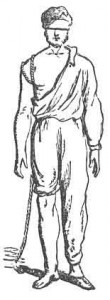by Moe | Aug 21, 2011 | Duncan's Masonic Ritual and Monitor
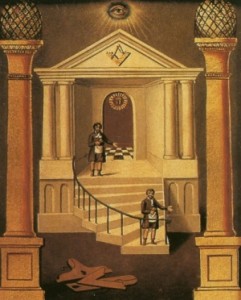
Duncan’s Masonic Ritual and Monitor
by Malcolm C. Duncan
[1866]
Start Reading
This book presents details of Masonic initiation rituals, along with grips, passwords and regalia. Written in the 19th century, Duncan’s Ritual, as it is known, has been republished numerous times. It includes the three basic degrees of the Ancient York Rite, and four additional advanced degrees. There are over a hundred illustrations, all reproduced here, which show important details of the rituals, including gestures and symbolic pictures. Duncan’s Ritual is careful to note known variations where they exist. This book will be of interest to beginning Masons who want a roadmap of the craft, as well as experienced Masons who need a review.
Title Page
Preface
Entered Apprentice, or First Degrees
Fellow Craft, or Second Degree
Master Mason, or Third Degree
Mark Master, or Fourth Degree
Past Master, or Fifth Degree
Most Excellent Master, or Sixth Degree
Royal Arch, or Seventh Degree
Extracts from a Dictionary of Masonry
Appendix
Moe is the founder of GnosticWarrior.com. He is a father, husband, author, martial arts black belt, and an expert in Gnosticism, the occult, and esotericism.
by Moe | Aug 21, 2011 | Duncan's Masonic Ritual and Monitor
DUNCAN’S
Masonic Ritual and Monitor
OR
GUIDE TO THE THREE SYMBOLIC DEGREES OF THE ANCIENT YORK RITE
AND
TO THE DEGREES OF MARK MASTER, PAST MASTER, MOST EXCELLENT MASTER, AND THE ROYAL ARCH
BY
MALCOLM C. DUNCAN
EXPLAINED AND INTERPRETED BY COPIOUS NOTES AND NUMEROUS ENGRAVINGS
THIRD EDITION
WITH ADDITIONS AND CORRECTIONS
New York: Dick & Fitzgerald
[1866]
NOTICE OF ATTRIBUTION
Scanned at sacred-texts.com, January, 2005. Proofed by John Bruno Hare. This text is in the public domain. These files may be used for any non-commercial purpose, provided this notice of attribution is left intact.
Next: Preface
Moe is the founder of GnosticWarrior.com. He is a father, husband, author, martial arts black belt, and an expert in Gnosticism, the occult, and esotericism.
by Moe | Aug 21, 2011 | Duncan's Masonic Ritual and Monitor
p. 3
THE objects which Freemasonry was founded to subserve are honorable and laudable; nor is it intended in the following pages to disparage the institution or to undervalue its usefulness. It has, at various times and in several countries, incurred the ill-will of political parties and of religious bodies, in consequence of a belief, on their part, that the organization was not so purely benevolent and philanthropic as its members proclaimed it to be. In the State of New York, many years ago, it was supposed, but we think unjustly, to wield a powerful political influence, and to employ it unscrupulously for sinister ends. The war between Masonry and Anti-Masonry which convulsed the State at that period is still fresh in the remembrance of many a party veteran. The Order, however, has long since recovered from the obloquy then heaped upon it, and is now in a flourishing condition in most parts of the civilized world.
The purpose of this work is not so much to gratify the curiosity of the uninitiated as to furnish a guide for the neophytes of the Order, by means of which their progress from grade to grade may be facilitated. Every statement in the book is authentic, as every proficient Mason will admit to himself, if not to be public, as he turns over its pages. The non-Masonic reader, as he peruses them, will perhaps be puzzled to imagine why matters of so little real importance to society at large should have been so industriously concealed for centuries, and still more surprised that society should have been so extremely inquisitive about them. “But such,” as Old Stapleton says, in ‘Jacob Faithful,’ “is human nature.” The object of the Order in making a profound mystery of its proceedings is obvious enough. Sea-birds are not more in-variably attracted toward a lighted beacon on a dark night, than men to whatever savors of mystery. Curiosity has had a much greater influence in swelling the ranks of Masonry than philanthropy and brotherly love. The institution, however, is now sufficiently popular to stand upon its own merits, without the aid of clap-trap, so “via the mantle that shadowed Borgia.”
It will be observed by the initiated, that the following exposition gives no information through which any person not a Mason could obtain admission to a Lodge. It is due to the Order that its meetings should not be disturbed by the intrusion of persons who do not contribute to its support, or to the furtherance of its humane design, and whose motives in seeking admission to its
p. 4
halls would be impertinent and ungentlemanly. The clew to the Sanctum Sanctorum is, therefore, purposely withheld.
In its spirit and intention Masonry is certainly not a humbug, and in its enlightened age so excellent an institution should not incur the liability of being classed with the devices of charlatanry by affecting to wear a mystic veil which has long been lifted, and of which we are free to say, that, unlike that of the false prophet of Kohrassan, it has no repulsive features behind it.
The author of the following work does not conceive that it contains a single line which can in any way injure the Masonic cause; while he believes, on the other hand, that it will prove a valuable made mecum to members of the Order, for whose use and guidance it is especially designed.
It will be seen that the “work” quoted in this treatise differs from that of Morgan, Richardson, and Alleyn; but as this discrepancy is fully explained at the close of the remarks on the Third Degree, it is not deemed necessary to make further allusion to it here.
p. 5
THE AUTHORITIES REFERRED TO IN THIS WORK ARE AS FOLLOWS:
“THE HISTORICAL LANDMARKS.” By the Rev. G. Oliver, D. D. In two volumes. London: R. Spencer. 1845.
“THE THEOCRATIC PHILOSOPHY OF FREEMASONRY.” By the same author and publisher. 1840.
“ORIGIN OF THE ENGLISH ROYAL ARCH.” By the same, &c., &c., &c.
“A LEXICON OF FREEMASONRY.” By Albert G. Mackey, M. D. Charleston: Burges & James. 1845.
“THE FREEMASON’S TREASURY.” By the Rev. George Oliver, D. D. London: R. Spencer. 1863.
Moe is the founder of GnosticWarrior.com. He is a father, husband, author, martial arts black belt, and an expert in Gnosticism, the occult, and esotericism.
by Moe | Aug 21, 2011 | Duncan's Masonic Ritual and Monitor
p. 6 p. 7
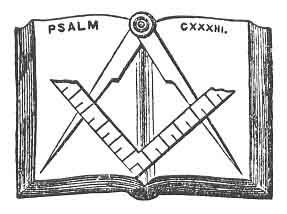 Seven Freemasons, viz., six Entered Apprentices and one Master Mason, acting under a charter or dispensation from some Grand Lodge, is the requisite number to constitute a Lodge of Masons, and to initiate a candidate to the First Degree of Masonry.
Seven Freemasons, viz., six Entered Apprentices and one Master Mason, acting under a charter or dispensation from some Grand Lodge, is the requisite number to constitute a Lodge of Masons, and to initiate a candidate to the First Degree of Masonry.
They assemble in a room well guarded from all cowans and eaves-droppers, in the second or third story (as the case may be) of some building suitably prepared and furnished for Lodge purposes, which is, by Masons, termed “the Ground Floor of King Solomon’s Temple.”
The officers take their seats, as represented in the Plate on page 8. Lodge-meetings are arranged as follows, viz.: a “regular” is held but once a month (i.e. every month on, or preceding, the full of the moon in each month); special meetings are held as often as the exigency of the case may seem to demand, if every night in the week, Sunday excepted. If Tuesday should be Lodge night, by Masons it would be termed, “Tuesday evening on or before the full of the moon, a regular night.”
p. 8
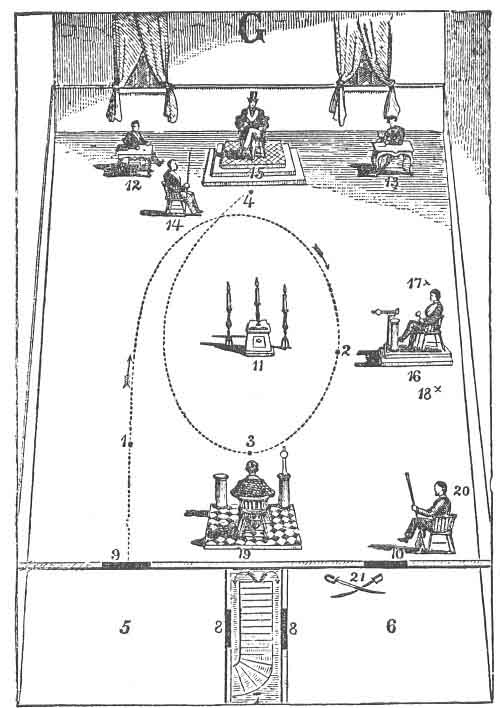
LODGE OF ENTERED APPRENTICES, FELLOW CRAFTS, OR MASTER MASONS. 1. Candidate prays. 2. First stop. 3. Second stop. 4. Third stop. 5. Room where candidates are prepared. 6. Ante-room where members enter the lodge. 7. Hall. 8. Doors. 9. Door through which candidates are admitted into the lodge. 10. Door through which members enter. 11. Altar. 12. Treasurer. 13. Secretary. 14. Senior Deacon. 15. Worshipful Master. 16. Junior Warden. 17 and 18. Stewards. 19. Senior Warden. 20. Junior Deacon. 21. Tyler.
p. 9
All business relative to Masonry is done at a “regular,” and in the Third, or Master Mason Degree. None but Master Masons are allowed to be present at such meetings; balloting for candidates is generally done on a “regular,” also receiving petitions, committee reports, &c., &c.
A petition for the degrees of Masonry is generally received at a “regular” (though, as a common thing, Grand Lodges of each State make such arrangements as they may deem best for the regulation of their several subordinate Lodges).
At the time of receiving a petition for the degrees of Masonry, the Master appoints a committee of three, whose duty it is to make inquiry after the character of the applicant, and report good or bad, as the case may be, at the next regular meeting, when it is acted upon by the Lodge.
Upon reception of the committee’s report, a ballot is had: if no black balls appear, the candidate is declared duly elected; but if one black ball or more appear, he is declared rejected.
No business is done in a Lodge of Entered Apprentices, except to initiate a candidate to the First Degree in Masonry, nor is any business done in a Fellow Crafts’ Lodge, except to pass a Fellow Craft from the first to the second degree. To explain more thoroughly: when a candidate is initiated to the First Degree, he is styled as “entered;” when he has taken the Second Degree, “passed.” and when he has taken the Third, “raised” to the sublime Degree of a Master Mason. No one is allowed to be present, in any degree of Masonry, except he be one of that same degree or higher. The Master always wears his hat when presiding as such, but no other officer, in a “Blue Lodge” (a “Blue Lodge” is a Lodge of Master Masons, where only three degrees are conferred, viz.: Entered Apprentice, 1st; Fellow Craft, 2d; Master Mason, 3d. Country Lodges are mostly all “Blue Lodges“).
A Lodge of Fellow Craft Masons consists of five, viz.: Worshipful Master, Senior and Junior Wardens, Senior and Junior Dear hens; yet seven besides the Tyler generally assist, and take their seats as in the Entered Apprentice’s Degree. The Fellow Craft Lodge is styled by Masons “the Middle Chamber of King Solomon’s Temple.”
Three Master Masons is the requisite number to constitute a Masters’ Lodge, which is called by Masons “the Sanctum Sanctorum, or, Holy of Holies of King Solomon’s Temple.” Although three are all that is required by “Masonic Law” to open a Third Degree Lodge, there are generally seven besides the Tyler, as in the other degrees.
Moe is the founder of GnosticWarrior.com. He is a father, husband, author, martial arts black belt, and an expert in Gnosticism, the occult, and esotericism.
by Moe | Aug 21, 2011 | Duncan's Masonic Ritual and Monitor
p. 58
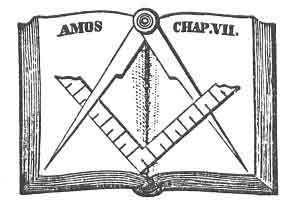 I SHALL omit the ceremonies incident to opening a Lodge of Fellow Crafts, as they are very similar to those employed in opening the First Degree, and will be explained hereafter more
I SHALL omit the ceremonies incident to opening a Lodge of Fellow Crafts, as they are very similar to those employed in opening the First Degree, and will be explained hereafter more
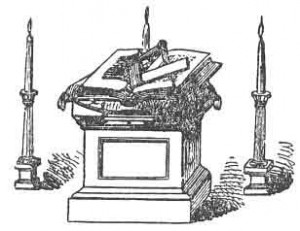 COMPASSES PLACED IN A LODGE OF FELLOW CRAFT MASONS, ”ONE POINT ELEVATED ABOVE THE SQUARE.” (See Note B.) COMPASSES PLACED IN A LODGE OF FELLOW CRAFT MASONS, ”ONE POINT ELEVATED ABOVE THE SQUARE.” (See Note B.) |
clearly to the reader. Five are required by Masonic law to make a legal Lodge of Fellow Crafts, viz.: Worshipful Master, Senior and Junior Wardens, Senior and .Junior Deacons; yet seven, besides the Tyler, generally officiate, and take their seats as in the Entered Apprentice Degree. (See Plate, page 8.)
When the Lodge is opened on the Fellow Craft Degree, the altar is arranged as represented in the accompanying engraving.
We will suppose the Lodge to be opened on the Fellow Craft Degree, and Mr. Gabe, who has previously taken the degree of Entered Apprentice, and been elected to that of Fellow Craft, is in the ante-room in waiting. The Master, being aware of this fact, will say:
p. 59
W. M.–Brother Junior Deacon, you will take with you the necessary assistance and repair to the ante-room, where there is a candidate in waiting for the second degree in Masonry; and when you have him prepared, make it known by the usual sign.
The Junior Deacon, with the two Stewards accompanying him, steps to the centre of the Lodge, makes the duegard and sign of a Fellow Craft, and passes out of the Lodge into the ante-room. (For duegard and sign see Figs. 3 and 4, page 17.)
J. D.–Well, Brother Gabe, you will have to be prepared for this Degree as all have been before you. You, of course, can have no serious objection?
Brother Gabe.–I have not.
J. D.–Then you will take off your boots, coat, pants, vest-necktie, and collar; and here is a pair of drawers, unless you have a pair of your own. Now you will slip
your right arm out of your shirtsleeve, and put it through the bosom of your shirt, that your right arm and breast may he naked.
The Deacon here ties a hoodwink, or hand-kerchief, over both eyes. (In the time of Morgan, it was the usage to cover only one eye.) The Junior Deacon then ties a rope, by Masons called a cable-tow, twice around his arm. (Formerly, the rope was put twice round the candidate’s neck.) Some Lodges follow the old custom now, but this is rather a rare thing. The reader will, however, do well to recollect these hints, as they are particular points.
The right foot and knee of the candidate are made bare by rolling up the drawers, and a slipper should be put on his left foot. This being accomplished, the candidate is duly and truly prepared. (See engraving.)
The Deacon now takes the candidate by the arm, and leads him forward to the door of the Lodge; and upon arriving there he gives three raps, when the Senior Deacon, who has taken his station on the inside door of the Lodge, reports to the Master as follows:
S. D.–Worshipful Master (making the sign of a Fellow Craft), there is an alarm at the inner door of our Lodge.
W. M.–You will attend to the alarm, and ascertain the cause.
p. 60
The Deacon gives three raps, which are responded to by the Junior Deacon, and answered to by one rap from the Senior Deacon inside, who opens the door, and says:
S. D.–Who comes here?
J. D. (conductor.)–Brother Gabe, who has been regularly initiated as Entered Apprentice, and now wishes to receive more light in Masonry by being passed to the degree of Fellow Craft.
S. D. (turning to candidate.)–Brother Gabe, is it of your own free-will and accord?
Moe is the founder of GnosticWarrior.com. He is a father, husband, author, martial arts black belt, and an expert in Gnosticism, the occult, and esotericism.
by Moe | Aug 21, 2011 | Duncan's Masonic Ritual and Monitor
p. 87
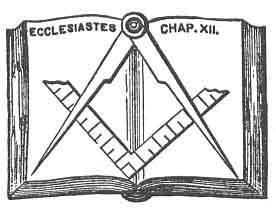 THE ceremony of opening and conducting the business of a Lodge of Master Masons is nearly the same as in the Entered Apprentice and Fellow Crafts’ Degrees, already explained. All the business of a “Blue Lodge” (a Lodge of three Degrees) is done in the Lodge while opened on this Degree, except that of entering an Apprentice or passing a Fellow Craft, when the Lodge is lowered from the Masters’ Degree for that purpose.
THE ceremony of opening and conducting the business of a Lodge of Master Masons is nearly the same as in the Entered Apprentice and Fellow Crafts’ Degrees, already explained. All the business of a “Blue Lodge” (a Lodge of three Degrees) is done in the Lodge while opened on this Degree, except that of entering an Apprentice or passing a Fellow Craft, when the Lodge is lowered from the Masters’ Degree for that purpose.
The Third Degree is said to be the height of Ancient Free-masonry, and the most sublime of all the Degrees in Masonry (Royal Arch not even excepted); and when it is conferred, the Lodge is generally well filled with the members of the Lodge and visiting brethren.
The traditional account of the death, several burials, and resurrections of one of the craft, Hiram Abiff, the widow’s son, as developed in conferring this Degree, is very interesting.
We read in the Bible, that Hiram Abiff was one of the head workmen employed at the building of King Solomon’s Temple, and other ancient writings inform us that he was an arbiter between King Solomon and Hiram, king of Tyre; but his tragical death is nowhere recorded, except in the archives of Freemasonry. Not even the Bible, the writings of Josephus, nor any other writings, however ancient, of which we have any knowledge, furnish any information respecting his death. It is very singular, that
p. 88
a man so celebrated as Hiram Abiff was, universally acknowledged as the third most distinguished man then living, and, in many respects, the greatest man in the world, should pass from off the stage of action, in the presence of King Solomon, three thousand three hundred grand overseers, and one hundred and fifty thousand workmen, with whom he had spent a number of years, and with King Solomon, his bosom friend, without any of his numerous confrères even recording his death, or any thing about it.
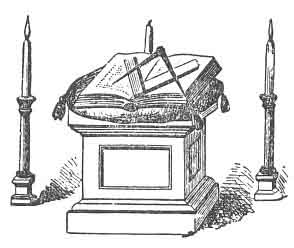 COMPASSES, PLACED IN A LODGE OF MASTER MASONS, ”BOTH POINTS ELEVATED ABOVE THE SQUARE,” (See Note B, Appendix.) COMPASSES, PLACED IN A LODGE OF MASTER MASONS, ”BOTH POINTS ELEVATED ABOVE THE SQUARE,” (See Note B, Appendix.) |
A Master Masons’ Lodge is styled by the Craft the “Sanctum Sanctorum, or Holy of Holies, of King Solomon’s Temple,” and when the Lodge is opened on this Degree, both points of the compasses are elevated above the square. (See engraving.)
A candidate for the sublime Degree of a Master Mason is generally (as in the preceding Degrees) prepared by the Junior Deacon and the two Stewards, or some other brethren acting as such.
PREPARING THE CANDIDATE
The candidate is divested of all wearing apparel, except his shirt and drawers, and if he has not the latter, he is furnished with a pair by the brethren preparing him. The drawers are rolled up just above the candidate’s knees, and both arms are taken out of his shirt-sleeves, leaving his legs and breast bare. A rope, technically called, by Masons, a cable-tow, is wound around his body three times, and a bandage, or hoodwink, is tied very closely over his eyes. (See engraving.)
When the candidate is prepared, the Deacon takes him by the left arm, leads him up to the door of the Lodge, and gives three loud, distinct knocks.
The Senior Deacon, who has stationed himself at the inner door, at the right of the Senior Warden, on hearing these raps rises to his feet, makes the sign of a Master Mason to the Master (see Fig. 6, p. 18), and says:
p. 89
Worshipful Master, while engaged in the lawful pursuit of Masonry, there is an alarm at the inner door of our Lodge.
W. M.–You will attend to the alarm, and ascertain the cause.
Senior Deacon gives three loud knocks (• • •), which are responded to by one (•) from the parties outside. The Senior Deacon then answers with one rap (•), and opens the door.
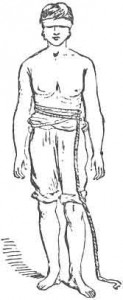 CANDIDATE DULY AND TRULY PREPARED. CANDIDATE DULY AND TRULY PREPARED. |
(See Note J, Appendix.)
Moe is the founder of GnosticWarrior.com. He is a father, husband, author, martial arts black belt, and an expert in Gnosticism, the occult, and esotericism.







